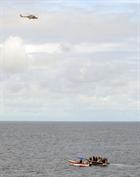Argyll's Lynx in counter-narcotics operations off Colombia
Royal Navy warship HMS Argyll has just completed an intense period of counter-narcotics operations in the Eastern Pacific Ocean before making her way back home to the UK. The Plymouth-based Type-23 frigate worked alongside her US, Canadian and Colombian allies to help deter potential drug traffickers from using the sea to transport their goods.
She had to use her full range of capabilities during the operations including stopping and searching suspect craft, searching for vessels using her powerful radar and launching her helicopter to search and, if necessary, stop suspect vessels.
During the counter narcotics operations Argyll embarked a 10-man strong United States Coast Guard Law Enforcement Detachment – which has state consent to board suspect vessels in the area. Having the US sailors on board is typical of the multi-national nature of the fight against drugs.
One of HMS Argyll’s key assets is their Lynx helicopter, known as Eagle One, which flew for over 37 hours during the counter-narcotics operations.
During this time Eagle One’s crew detected and deterred illegal activity and found numerous suspicious vessels strongly suspected of smuggling or supporting other vessels actively engaged in smuggling.
Flight 211, which fly the Lynx, are part of 815 Naval Air Squadron based at Royal Naval Air Squadron Yeovilton.
“Eastern Pacific operations such as this have not taken place for a while,” said Flight Commander Lieutenant Ben Jewson.
“The first thing we had to get to grips with was understanding Counter Narcotics operations on the west side of the Panama Canal.”
Eagle One covered thousands of square miles every day in the pursuit of drug smugglers and illegal maritime activity at all times of the day and night.
The normal flight crew of pilot and observer were augmented by the US Coast Guard airborne controller, who provided local intelligence and advice.
In case a “go-fast” boat, as the drug smugglers craft are known, was unwilling to stop - 211 Flight were further augmented with two marine snipers.
“The marines have the job of targeting the outboard engines of any ‘Go-Fast’ type boat in order to bring that vessel to a halt.” said one of the US Coast Guard Airborne Controllers.
“The accuracy of shot from the cramped confines of a Lynx helicopter into the engines of a ‘Go fast’ moving at speed is unnerving,” he added.
As well as her counter-drugs operations, Argyll also had to rapidly switch to a less aggressive posture as she led a Search and Rescue mission for a yacht before quickly changing her role back when re-directed a few days later.
This work is part of Operation Martillo, a 15-nation collaborative effort to deny trans-national criminal organisations air and maritime access to the littoral regions of Central America, and focus on putting a stop to the illegal movement of drugs from South America to the western world.
“I am extremely proud of the hard work put in my crew and the US Coast Guard team during this period of high-tempo counter narcotics operations,” said Commander Tim Neild, HMS Argyll’s Commanding Officer.
“We have provided a most effective counter narcotics capability during this period and when you consider the other roles we have undertaken during our seven-month deployment Argyll has really showcased the capability and flexibility of a Royal Navy warship.’’
The Royal Navy contributes to counter-narcotics operations across the globe whether it be cannabis and cocaine in the Eastern Pacific and Caribbean or intercepting insurgent heroin traffic using its Sea King air surveillance helicopters in Afghanistan.
HMS Argyll, which was on a seven-month South Atlantic deployment, will now hold regional engagement visits before returning to her Devonport home next month.


